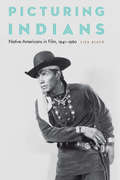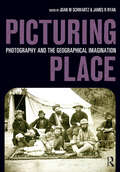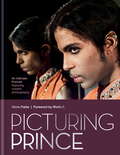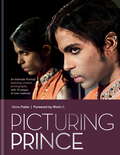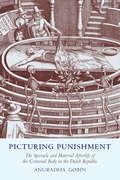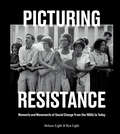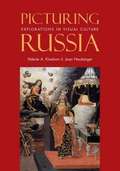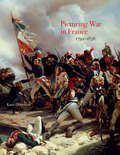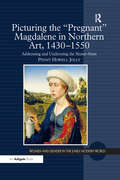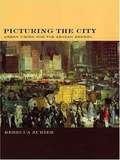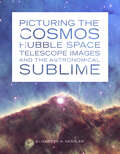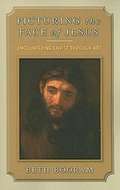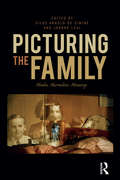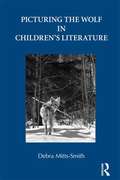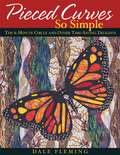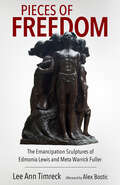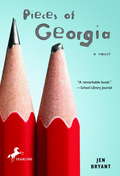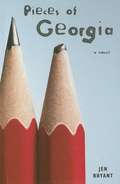- Table View
- List View
Picturing Indians: Native Americans in Film, 1941-1960
by Liza BlackStanding at the intersection of Native history, labor, and representation, Picturing Indians presents a vivid portrait of the complicated experiences of Native actors on the sets of midcentury Hollywood Westerns. This behind-the-scenes look at costuming, makeup, contract negotiations, and union disparities uncovers an all-too-familiar narrative of racism and further complicates filmmakers&’ choices to follow mainstream representations of &“Indianness.&” Liza Black offers a rare and overlooked perspective on American cinema history by giving voice to creators of movie Indians—the stylists, public relations workers, and the actors themselves. In exploring the inherent racism in sensationalizing Native culture for profit, Black also chronicles the little-known attempts of studios to generate cultural authenticity and historical accuracy in their films. She discusses the studios&’ need for actual Indians to participate in, legitimate, and populate such filmic narratives. But studios also told stories that made Indians sound less than Indian because of their skin color, clothing, and inability to do functions and tasks considered authentically Indian by non-Indians. In the ongoing territorial dispossession of Native America, Native people worked in film as an economic strategy toward survival. Consulting new primary sources, Black has crafted an interdisciplinary experience showcasing what it meant to &“play Indian&” in post–World War II Hollywood.
Picturing Place: Photography and the Geographical Imagination
by James R. Ryan Joan M. SchwartzThe advent of photography opened up new worlds to 19th century viewers, who were able to visualize themselves and the world beyond in unprecedented detail. But the emphasis on the photography's objectivity masked the subjectivity inherent in deciding what to record, from what angle and when. This text examines this inherent subjectivity. Drawing on photographs that come from personal albums, corporate archives, commercial photographers, government reports and which were produced as art, as record, as data, the work shows how the photography shaped and was shaped by geographical concerns.
Picturing Prince: An Intimate Portrait
by Steve ParkePICTURING PRINCE sees the late icon's former art director, STEVE PARKE, revealing stunning intimate photographs of the singer from his time working at Paisley Park. At least half of the images in the book are exclusively published here for the first time; most other images in the book are rare to the public eye.Alongside these remarkable images are fifty engaging, poignant and often funny written vignettes by Parke, which reveal the very human man behind the reclusive superstar: from shooting hoops to renting out movie theatres at 4am; from midnight requests for camels to meaningful conversations that shed light on Prince as a man and artist. STEVE PARKE started working with Prince in 1988, after a mutual friend showed Prince some of Steve's photorealistic paintings. He designed everything from album covers and merchandise to sets for Prince's tours and videos. Somewhere in all of this, he became Paisley Park's official art director. He began photographing Prince at the request of the star himself, and continued to do so for the next several years. The images in this book are the arresting result of this collaboration.
Picturing Prince: An Intimate Portrait
by Steve ParkePICTURING PRINCE sees the late icon's former art director, STEVE PARKE, revealing stunning intimate photographs of the singer from his time working at Paisley Park. At least half of the images in the book are exclusively published here for the first time; most other images in the book are rare to the public eye.Alongside these remarkable images are fifty engaging, poignant and often funny written vignettes by Parke, which reveal the very human man behind the reclusive superstar: from shooting hoops to renting out movie theatres at 4am; from midnight requests for camels to meaningful conversations that shed light on Prince as a man and artist. STEVE PARKE started working with Prince in 1988, after a mutual friend showed Prince some of Steve's photorealistic paintings. He designed everything from album covers and merchandise to sets for Prince's tours and videos. Somewhere in all of this, he became Paisley Park's official art director. He began photographing Prince at the request of the star himself, and continued to do so for the next several years. The images in this book are the arresting result of this collaboration.
Picturing Prince: An Intimate Portrait
by Steve ParkePICTURING PRINCE sees the late icon's former art director, STEVE PARKE, revealing stunning intimate photographs of the singer from his time working at Paisley Park. At least half of the images in the book are exclusively published here for the first time; most other images in the book are rare to the public eye.Alongside these remarkable images are fifty engaging, poignant and often funny written vignettes by Parke, which reveal the very human man behind the reclusive superstar: from shooting hoops to renting out movie theatres at 4am; from midnight requests for camels to meaningful conversations that shed light on Prince as a man and artist. STEVE PARKE started working with Prince in 1988, after a mutual friend showed Prince some of Steve's photorealistic paintings. He designed everything from album covers and merchandise to sets for Prince's tours and videos. Somewhere in all of this, he became Paisley Park's official art director. He began photographing Prince at the request of the star himself, and continued to do so for the next several years. The images in this book are the arresting result of this collaboration.
Picturing Prince: An Intimate Portrait
by Steve ParkePICTURING PRINCE sees the late icon's former art director, STEVE PARKE, revealing stunning intimate photographs of the singer from his time working at Paisley Park. At least half of the images in the book are exclusively published here for the first time; most other images in the book are rare to the public eye.Alongside these remarkable images are fifty engaging, poignant and often funny written vignettes by Parke, which reveal the very human man behind the reclusive superstar: from shooting hoops to renting out movie theatres at 4am; from midnight requests for camels to meaningful conversations that shed light on Prince as a man and artist. STEVE PARKE started working with Prince in 1988, after a mutual friend showed Prince some of Steve's photorealistic paintings. He designed everything from album covers and merchandise to sets for Prince's tours and videos. Somewhere in all of this, he became Paisley Park's official art director. He began photographing Prince at the request of the star himself, and continued to do so for the next several years. The images in this book are the arresting result of this collaboration.
Picturing Punishment: The Spectacle and Material Afterlife of the Criminal Body in the Dutch Republic
by Anuradha GobinPicturing Punishment examines representations of criminal bodies as they moved in, through, and out of publicly accessible spaces in the city during punishment rituals in the seventeenth-century Dutch Republic. Once put to death, the criminal cadaver did not come to rest. Its movement through public spaces indicated the potent afterlife of the deviant body, especially its ability to transform civic life. Focusing on material culture associated with key sites of punishment, Anuradha Gobin argues that the circulation of visual media related to criminal punishments was a particularly effective means of generating discourse and formulating public opinion, especially regarding the efficacy of civic authority. Certain types of objects related to criminal punishments served a key role in asserting republican ideals and demonstrating the ability of officials to maintain order and control. Conversely, the circulation of other types of images, such as inexpensive paintings and prints, had the potential to subvert official messages. As Gobin shows, visual culture thus facilitated a space in which potentially dissenting positions could be formulated while also bringing together seemingly disparate groups of people in a quest for new knowledge. Combining a diverse array of sources including architecture, paintings, prints, anatomical illustrations, and preserved body parts, Picturing Punishment demonstrates how the criminal corpse was reactivated, reanimated, and in many ways reintegrated into society.
Picturing Reform in Victorian Britain
by Janice CarlisleHow did Victorians, as creators and viewers of images, visualize the politics of franchise reform? This study of Victorian art and parliamentary politics, specifically in the 1840s and 1860s, answers that question by viewing the First and Second Reform Acts from the perspectives offered by Ruskin's political theories of art and Bagehot's visual theory of politics. Combining subjects and approaches characteristic of art history, political history, literary criticism, and cultural critique, Picturing Reform in Victorian Britain treats both paintings and wood engravings, particularly those published in Punch and the Illustrated London News. Carlisle analyzes unlikely pairings - a novel by Trollope and a painting by Hayter, an engraving after Leech and a high-society portrait by Landseer - to argue that such conjunctions marked both everyday life in Victorian Britain and the nature of its visual politics as it was manifested in the myriad heterogeneous and often incongruous images of illustrated journalism.
Picturing Resistance: Moments and Movements of Social Change from the 1950s to Today
by Ken Light Melanie LightA compelling photographic history of the important moments of progressive resistance--from the civil rights movement to the present--to inspire the change-makers and activists of today.A powerful commemoration of notable moments of protest, Picturing Resistance highlights the important American social justice movements of the last seven decades. Including both black-and-white and color photographs, this important record pairs iconic and unexpected images with insightful narrative captions that contextualize the meanings behind the moments. UC Berkeley Graduate School of Journalism professor Ken Light and author Melanie Light have carefully curated unconventional photographs of the most memorable moments in twentieth- and twenty-first-century protest history, offering a fresh perspective on these important occasions. In place of the iconic image of Martin Luther King, Jr. speaking at the March on Washington, Picturing Resistance conveys the feeling of pain and frustration of the time period by instead showing him moments after being arrested, restrained against a police station table. The moments captured in Picturing Resistance take the reader on a journey through decades of people-powered protest, featuring images from the front lines of the civil rights, women's, environmental, and disability rights movements, as well as contemporary movements like Black Lives Matter and March for Our Lives. Picturing Resistance will inspire revolutionary thinkers, activists, and dreamers of all stripes to celebrate the milestones of the past as we build a progressive future.
Picturing Russia: Explorations in Visual Culture
by Joan Neuberger Valerie A. KivelsonThis wide-ranging book is the first to explore the visual culture of Russia over the entire span of Russian history, from ancient Kiev to contemporary, post-Soviet society. Illustrated with more than one hundred diverse and fascinating images, the book examines the ways that Russians have represented themselves visually, understood their visual environment, and used visual images in social and political contexts.
Picturing Victorian America: Prints by the Kellogg Brothers of Hartford, Connecticut, 1830-1880
by Kate Steinway Nancy FinlayThis is the first book-length account of the pioneering and prolific Kellogg family of lithographers, active in Connecticut for over four decades. Daniel Wright Kellogg opened his print shop on Main Street in Hartford five years before Nathaniel Currier went into a similar business in New York and more than twenty-five years before Currier founded his partnership with James M. Ives, yet Daniel and his brothers Elijah and Edmund Kellogg have long been overshadowed by the Currier & Ives printmaking firm. Editor Nancy Finlay has gathered together eight essays that explore the complexity of the relationships between artists, lithographers, and print, map, and book publishers. Presenting a complete visual overview of the Kelloggs' production between 1830 and 1880, Picturing Victorian America also provides museums, libraries, and private collectors with the information needed to document the Kellogg prints in their own collections. The first comprehensive study of the Kellogg prints, this book demands reconsideration of this Connecticut family's place in the history of American graphic and visual arts.CONTRIBUTORS: Georgia B. Barnhill, Lynne Zacek Bassett, Candice C. Brashears, Nancy Finlay, Elisabeth Hodermarsky, Richard C. Malley, Sally Pierce, Michael Shortell, Kate Steinway.
Picturing War in France, 1792†“1856
by Katie HornsteinFrom the walls of the Salon to the pages of weekly newspapers, war imagery was immensely popular in postrevolutionary France. This fascinating book studies representations of contemporary conflict in the first half of the 19th century and explores how these pictures provided citizens with an imaginative stake in wars being waged in their name. As she traces the evolution of images of war from a visual form that had previously been intended for mostly elite audiences to one that was enjoyed by a much broader public over the course of the 19th century, Katie Hornstein carefully considers the influence of emergent technologies and popular media, such as lithography, photography, and panoramas, on both artistic style and public taste. With close readings and handsome reproductions in various media, from monumental battle paintings to popular prints, Picturing War in France,1792–1856 draws on contemporary art criticism, war reporting, and the burgeoning illustrated press to reveal the crucial role such images played in shaping modern understandings of conflict.
Picturing the 'Pregnant' Magdalene in Northern Art, 1430-1550: Addressing and Undressing the Sinner-Saint (Women and Gender in the Early Modern World)
by Penny Howell JollyExamining innovations in Mary Magdalene imagery in northern art 1430 to 1550, Penny Jolly explores how the saint’s widespread popularity drew upon her ability to embody oppositions and embrace a range of paradoxical roles: sinner-prostitute and saint, erotic seductress and holy prophet. Analyzing paintings by Rogier van der Weyden, Quentin Massys, and others, Jolly investigates artists’ and audiences’ responses to increasing religious tensions, expanding art markets, and changing roles for women. Using cultural ideas concerning the gendered and pregnant body, Jolly reveals how dress confirms the Magdalene’s multivalent nature. In some paintings, her gown’s opening laces betray her wantonness yet simultaneously mark her as Christ’s spiritually pregnant Bride; elsewhere ’undress’ reconfirms her erotic nature while paradoxically marking her penitence; in still other works, exotic finery expresses her sanctity while celebrating Antwerp’s textile industry. New image types arise, as when the saint appears as a lovesick musician playing a lute or as a melancholic contemplative, longing for Christ. Some depictions emphasize her intercessory role through innovative pictorial strategies that invite performative viewing or relate her to the mythological Pandora and Italian Renaissance Neoplatonism. Throughout, the Magdalene’s ambiguities destabilize readings of her imagery while engaging audiences across a broad social and religious spectrum.
Picturing the City: Urban Vision and the Ashcan School
by Rebecca ZurierPicturing the City takes a fresh look at the well-loved Ashcan School artists, a group of artists who sought to document everyday life in turn-of-the-century New York City, capturing it in realistic and unglamorized paintings and etchings of urban street scenes.
Picturing the Cosmos: Hubble Space Telescope Images and the Astronomical Sublime
by Elizabeth A. KesslerThe vivid, dramatic images of distant stars and galaxies taken by the Hubble Space Telescope have come to define how we visualize the cosmos. In their immediacy and vibrancy, photographs from the Hubble show what future generations of space travelers might see should they venture beyond our solar system. But their brilliant hues and precise details are not simply products of the telescope&’s unprecedented orbital location and technologically advanced optical system. Rather, they result from a series of deliberate decisions made by the astronomers who convert raw data from the Hubble into spectacular pictures by assigning colors, adjusting contrast, and actively composing the images, balancing the desire for an aesthetically pleasing representation with the need for a scientifically valid one.In Picturing the Cosmos, Elizabeth A. Kessler examines the Hubble&’s deep space images, highlighting the remarkable resemblance they bear to nineteenth-century paintings and photographs of the American West and their invocation of the visual language of the sublime. Drawing on art history and the history of science, as well as interviews with astronomers who work on the Hubble Heritage Project, Kessler traces the ways that the sublime, with its inherent tension between reason and imagination, not only forms the appearance of the images, but also operates on other levels. The sublime informs the dual expression—numeric and pictorial—of digital data and underpins the relevance of the frontier for a new era of exploration performed by our instruments rather than our bodies. Through their engagement with the sublime the Hubble images are a complex act of translation that encourages an experience of the universe as simultaneously beyond humanity&’s grasp and within the reach of our knowledge.Strikingly illustrated with full-color images, this book reveals the scientific, aesthetic, and cultural significance of the Hubble pictures, offering a nuanced understanding of how they shape our ideas—and dreams—about the cosmos and our places within it.
Picturing the Face of Jesus: Encountering Christ through Art
by Beth BooramFor many who identify themselves as Christians, Jesus has never become experientially personal or real. Countless others who have faithfully followed Christ confess to a spiritual dryness and lack of joy. These individuals are weary and unmoved by the plethora of information about Jesus. What they long for is an experience with Jesus.Picturing the Face of Jesus is an invitation to experience Christ more deeply. Through a rich palette of experiential media—art contemplation, gospel story-telling, and imaginative prayer—the reader is invited to picture the face of Jesus, his expressive, one-of-a-kind, human face. As a result, Jesus will become a real person with whom they candidly relate, instead of a hero they merely admire. Through this encounter, their own hearts will be transformed as they begin to reflect the face of Christ to others.
Picturing the Family: Media, Narrative, Memory
by Silke Arnold-de Simine; Joanne LealWhether pasted into an album, framed or shared on social media, the family photograph simultaneously offers a private and public insight into the identity and past of its subject. Long considered a model for understanding individual identity, the idea of the family has increasingly formed the basis for exploring collective pasts and cultural memory. Picturing the Family investigates how visual representations of the family reveal both personal and shared histories, evaluating the testimonial and social value of photography and film.Combining academic and creative, practice-based approaches, this collection of essays introduces a dialogue between scholars and artists working at the intersection between family, memory and visual media. Many of the authors are both researchers and practitioners, whose chapters engage with their own work and that of others, informed by critical frameworks. From the act of revisiting old, personal photographs to the sale of family albums through internet auction, the twelve chapters each present a different collection of photographs or artwork as case studies for understanding how these visual representations of the family perform memory and identity. Building on extensive research into family photographs and memory, the book considers the implications of new cultural forms for how the family is perceived and how we relate to the past. While focusing on the forms of visual representation, above all photographs, the authors also reflect on the contextualization and ‘remediation’ of photography in albums, films, museums and online.
Picturing the Wolf in Children's Literature (Children's Literature and Culture #69)
by Debra Mitts-SmithFrom the villainous beast of “Little Red Riding Hood” and “The Three Little Pigs,” to the nurturing wolves of Romulus and Remus and Rudyard Kipling’s The Jungle Book, the wolf has long been a part of the landscape of children’s literature. Meanwhile, since the 1960s and the popularization of scientific research on these animals, children’s books have begun to feature more nuanced views. In Picturing the Wolf in Children’s Literature, Mitts-Smith analyzes visual images of the wolf in children’s books published in Western Europe and North America from 1500 to the present. In particular, she considers how wolves are depicted in and across particular works, the values and attitudes that inform these depictions, and how the concept of the wolf has changed over time. What she discovers is that illustrations and photos in works for children impart social, cultural, and scientific information not only about wolves, but also about humans and human behavior. First encountered in childhood, picture books act as a training ground where the young learn both how to decode the “symbolic” wolf across various contexts and how to make sense of “real” wolves. Mitts-Smith studies sources including myths, legends, fables, folk and fairy tales, fractured tales, fictional stories, and nonfiction, highlighting those instances in which images play a major role, including illustrated anthologies, chapbooks, picture books, and informational books. This book will be of interest to children’s literature scholars, as well as those interested in the figure of the wolf and how it has been informed over time.
Piece of My Heart
by Lynn Maddalena MennaStill in high school, Marisol Reyes gets the chance of a lifetime to be a real singer, and she leaps at it. After all, this is the dream she held on to, all the days and nights she spent growing up on means streets of East Harlem. Marisol never gave in--no matter what her boyfriend or her best friend had to say. Who cares if only one in a hundred pretty, talented girls make it? She will be the one. In her rush to fame, Marisol tramples on the heart of her loyal best friend, and Julian, the boy she loves. But will it be worth it?One night at a private gig in the Hamptons, the little Latino girl with the big voice from East Harlem gets a severe reality check. A famous rapper who claims to be interested in her talents turns out to be interested in something else, threatening not only Marisol's dreams but her body and soul. Will the realities of the gritty New York music scene put out the stars in Marisol's eyes forever?
Pieced Curves So Simple: The 6-Minute Circle and Other Time-Saving Delights
by Dale FlemingStitch Circles and Curves - the Fast, Accurate, EASY Way! • Dale's fast, easy, pinless technique really works for machine-sewing curves and circles • Think like a designer - Dale demystifies color, balance, unity, and more! • Design-as-you-go techniques bring out your creativity • Discover a variety of easy ways to make your own patterns
Pieces of Freedom: The Emancipation Sculptures of Edmonia Lewis and Meta Warrick Fuller (Margaret Walker Alexander Series in African American Studies)
by Lee Ann TimreckThe history of racism in America is also the history of ordinary Black Americans who accomplished extraordinary things in their pursuit of freedom. Faced with oppression throughout their journey, they built vibrant communities and lived purposeful lives. Pieces of Freedom: The Emancipation Sculptures of Edmonia Lewis and Meta Warrick Fuller brings that history to life by analyzing the first fifty years of Black freedom through the emancipation sculptures of two nineteenth-century African American sculptors, Mary Edmonia Lewis (1844–1909) and Meta Warrick Fuller (1877–1968).Lewis's and Fuller’s sculptures—and their visual narrative of a people’s strength and humanity in the face of oppression—present a textured historical diorama of Black life during an era of transformative, yet sorrowful, events. In this book, Lee Ann Timreck integrates Lewis's and Fuller’s visual narrative with oral narratives of the newly emancipated, all set within the historical context of Reconstruction, segregation, and Jim Crow. The sculptures also reflect the artists’ gendered perspective of emancipation, conveying a strong narrative on the contributions and sacrifices made by newly freed Black women. These emancipation sculptures provide both a historical narrative of the Black emancipation experience and a moral narrative of America’s failure to create a nation where “all men are created equal.” Pieces of Freedom challenges the twenty-first-century reader to learn and accept this history so we might address our nation’s lingering social and economic injustices.
Pieces of Georgia
by Jen BryantLike her mother, Georgia McCoy is an artist, but her dad looks away whenever he sees her with a sketchbook. Sometimes it’s hard to remember what it was like when her mother was still alive . . . when they were a family . . . when they were happy. But then a few days after her 13th birthday, Georgia receives an unexpected gift–a strange, formal letter, all typed up and signed anonymous–granting her free admission to the Brandywine River Museum for a whole year. And things begin to change. An accessible novel in poems, Pieces of Georgia offers an endearing protagonist–an aspiring artist, a grieving daughter, a struggling student, a genuine friend–and the poignant story of a broken family coming together. From the Hardcover edition.
Pieces of Georgia
by Jennifer BryantIn journal entries to her mother, a gifted artist who died suddenly, thirteen-year-old Georgia McCoy reveals how her life changes after she receives an anonymous gift membership to a nearby art museum.
Pieces of Me
by Charlotte Gingras Susan OuriouMirabelle's art teacher tells her she has talent, but what good is it doing her. Almost fifteen and friendless, Mira is plagued by dark thoughts. Her body seems to be changing daily. Her mother is domineering and half-crazy and her father -- well, he's her ex-father, mostly out of Mira's life and awkward when he's around.
Pieces of My Heart: A Life
by Robert J. Wagner Scott EymanThe Hollywood icon tells about his rise to Hollywood stardom among legends like Cary Grant and Barbara Stanwyck and his troubled marriage, divorce, and remarriage to starlet Natalie Wood.In the revelation-filled memoir from one of Hollywood’s most talented actors, readers have a candid and deeply personal look at the life and career of Robert Wagner. Wagner’s long career began in the Hollywood of the 1950s, when studios were dominant and even the love lives of actors were dictated by what benefited the studio. His memoirs will chronicle in a very personal way his rise to stardom, his decline, and his resurrection. Wagner will talk candidly about his famous relationship with Natalie Wood and the circumstances surrounding her tragic death. His friendships and stories include major Hollywood personalities in the last half of the 20th century.When his family moved to Los Angeles, a young Wagner held a variety of jobs (including one as a caddy for Clark Gable) while pursuing his goal, but it was while dining with his parents at a restaurant in Beverly Hills that he was “discovered” by a talent scout.Known as much for his on-screen abilities as his off-screen personal heartbreak, Wagner will discuss for the first time his complicated and ultimately tragic relationship with Hollywood sweetheart Natalie Wood. It was implied that Wagner played a role in Natalie Wood’s tragic drowning off the coast of Catalina Island in 1981 and Wagner, for the first time ever, will set the record straight.With at least two dozen photos to illustrate his real Hollywood-style tell-all, this will be the extremely candid autobiography of Robert Wagner.
